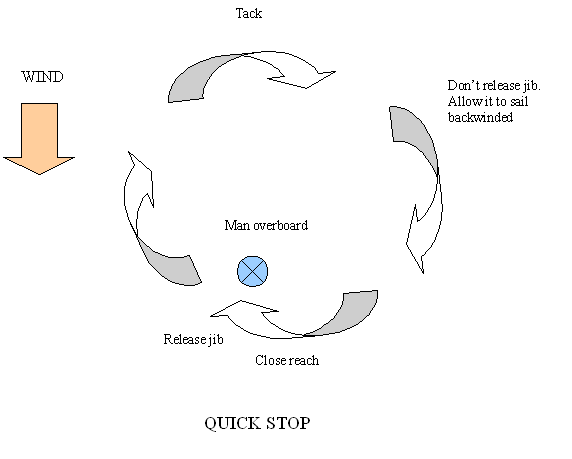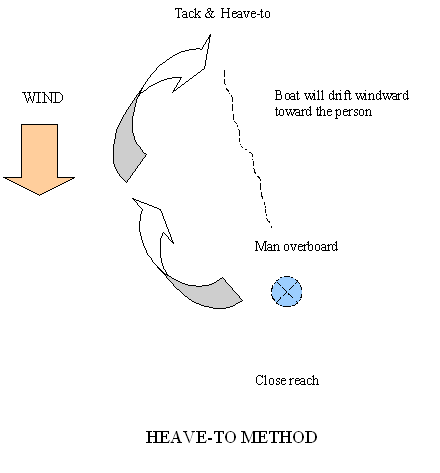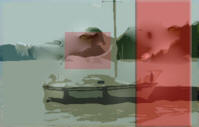Safety &
Rescue
|
It is
impossible to plan for all possible dangers at sea, but a wise sailor
anticipates and prepares for the worse. He then relies on skill,
luck, and his own ingenuity to get him through the unexpected. |
Fuel Range
| Before
leaving port, you need to compute your fuel range for the journey.
This requires knowledge of your average boat speed, distance you intend
to travel, fuel consumption of your engine, and fuel capacity of the
boat.
When computing the
range, it is often best to compute the range with a fuel capacity 1/8
less than the actual capacity of the boat. |
One Third Rule
When
calculating fuel range, remember the 1/3 Rule
1/3 to
get there
1/3 to
get back
1/3 in
reserve |
Computing Fuel Range
Speed
(knots) X Fuel capacity (gallons) = Consumption (gallons/hour) X
Distance (nautical miles)
Range
(distance) = (Fuel capacity X speed) ÷ Fuel consumption
The
range is the distance you can travel on that amount of fuel. |
Fire Extinguishers
| Boats
with engines must carry USCG approved fire extinguishers except boats
smaller than 26 feet that have outboard motors and no enclosed
compartments where gas fume can collect. Boats larger than 26 feet
can usually meet the requirements by carrying two or three extinguishers
of size I or II (sizes are marked on the extinguishers). |
| Class
A - Used for combustible material that leaves ash.
Class B - Used for
flammable liquid. Fights fire with carbon dioxide or dry chemical.
Class C - Used for
electrical fires. |
Dry
chemical - Messy but good fire fighting properties.
Halon - Good below
deck but not above deck.
Carbon dioxide - Good
in unoccupied, closed space. |
Man Overboard
|
In the
event of a man overboard, it is imperative that you act quickly.
Whoever first spots a man overboard should immediately shout "Man
overboard!" to alert the crew.
One
person should be assigned to keep a constant eye on the person overboard
while continually pointing to the person in the water. The person
assigned to watch should not take his eyes off the man in the water for
even a second or risk losing sight of the man.
Lifejackets,
throwable personal flotation devices (PFDs), and anything else that
floats should be thrown into the water. This will litter the water
and mark the area where the man fell overboard and also provide the man
in the water with flotation devices.
If a GPS
is available, a man overboard waypoint should be immediately set and
rescue operations should begin. Be careful trying to retrieve a
man overboard under power. The propellers can present a grave
danger to the man in the water. |
|

|
|
Figure
Eight Method
Sail a maximum of four
boat lengths on a beam reach.
Tack into the wind and
fall off on a very broad reach. Cross the boat's original course.
Head up into a close
reach when the person is abeam of the boat. Release the jib.
Ease the main and
bring the boat to a stop beside the person. |
 |
|
Quick
Stop Method
Immediately turn the
boat to wind and perform a tack. Allow the jib to backwind.
Sail on a beam to
broad reach for two or three boat lengths and then head downwind.
Hold the downwind
course until the person is abeam of the boat.
Jibe the boat and
release the jib.
Approach the person on
a close reach and bring the boat to a stop beside the person. |
|

|
|
Heave-to
Method
Immediately tack the
boat, but don't release the jib.
Move and secure the
tiller to leeward, and trim the mainsail so the boat lies closed-hauled
or on a close reach (hove-to).
While hove-to, the
boat will make slow progress leeward and should end up just windward of
the person in the water. |
Float Plan
| You
should always leave a float plan with a friend or relative--do not file
a float plan with the Coast Guard.
The float plan should
give a complete description of the boat and passengers and the expected
itinerary. But most important, the float plan should contain the
time and date to contact authorities if you have not returned, and it
should have the telephone numbers of the appropriate authorities
What to include on a
float plan
1.
Your name, address, and telephone number.
2.
Description of the boat: type, color, trim, registration numbers.
3.
Number of persons aboard: names, addresses, ages.
4.
Medical problems of any crew members.
5.
Engine information: number, type, horsepower, fuel capacity.
6.
Survival equipment and number: PFDs, flares, mirror, smoke
signals, flashlight, food, paddles, water, anchors, dinghy, EPIRB.
7.
Radio: number, type, frequency.
8.
Expected trip itinerary: dates and destinations.
9.
Automobile information: make, year, model, color, license number,
and where parked.
10.
Trailer information: make, year, license number, and where parked.
11.
Date and time of your expected return.
12.
Date to notify Coast Guard or local authority if you haven't
returned.
13.
Phone numbers and addresses where Coast Guard or local authority
can be reached. |
Upon your
return, do not forget to announce your return to the person with whom you
left the float plan. |
Essential Offshore Safety Equipment
| Two
anchors of appropriate size and strength with three fathoms of chain and
sufficient rode.
Life jackets, one for
each person on board.
Throwable lifesaving
device with dye marker, automatic light, and whistle.
Life raft rated for
the number of people on board.
Fire extinguishers
rate for all the systems on board.
Working compass and
spare, both adjusted for the vessel.
Charts of the area of
use.
Distress signaling
devices—smoke for day, flares for night.
Towrope and bridle of
a size and strength to handle the vessel in the worst conditions
encountered, and a light messenger line with a monkey’s fist or other
appropriate weight at the throwing end.
First-aid kit.
Radio receiver capable
of receiving marine weather reports and bulletins.
Waterproof flashlight
with spare batteries.
Radar reflector.
Patching materials for
leaks, collisions, broken hoses, etc.
Tool kit: mechanic’s
tools for engine repairs and carpenter’s tools for damage control.
Spare parts for
essential systems.
Safety harness for
deck work in foul weather and repairs aloft. |
Coast Guard Droppable, Floatable Pumps
| The
Coast Guard often provides vessels in distress with emergency pumps by
either making parachute drops, by lowering on helicopter hoist, or by
delivering by vessel. The most commonly used type of pump comes complete
in a sealed aluminum drum about half the size of a 50-gallon oil drum.
One single lever on top opens it up. Don't be smoking, as there may be
gas fumes inside the can. The pump will draw about 90 gallons per
minute. There should be a waterproof flashlight on top of the pump for
night use. Operating instructions are provided inside the pump
container.
--United States Coast Pilot, 31st
edition, 1998 |
How to Make a Distress Call
The
distress call consists of:
| --the
distress signal MAYDAY (spoken three times);
--the words
THIS IS (spoken once);
--the call
sign or name of the vessel in distress (spoken three times). |
The distress message
follows immediately and consists of:
| --the
distress signal MAYDAY;
--the call
sign and name of the vessel in distress:
--particulars
of its position (latitude and longitude, or true bearing and
distance from a known geographical position);
--the nature
of the distress;
--the kind of
assistance desired;
--the number
of persons aboard and the condition of any injured;
--present
seaworthiness of the vessel;
--description
of the vessel (length, type, cabin, masts, power, color of hull,
superstructure, trim, etc.);
--any other
information which might facilitate the rescue, such as display
of a surface-to-air identification signal or a radar reflector;
--your
listening frequency and schedule;
--THIS IS
(call sign and name of vessel in distress). OVER. |
Only use MAYDAY when
loss of life or vessel is imminent.
Use PAN PAN
(pronounced "pon-pon") when you have an urgent message
concerning safety of a person or vessel.
Use SECURITE
(pronounced "say-curatay") when you have a message about
navigational safety or weather. |
|




![]()